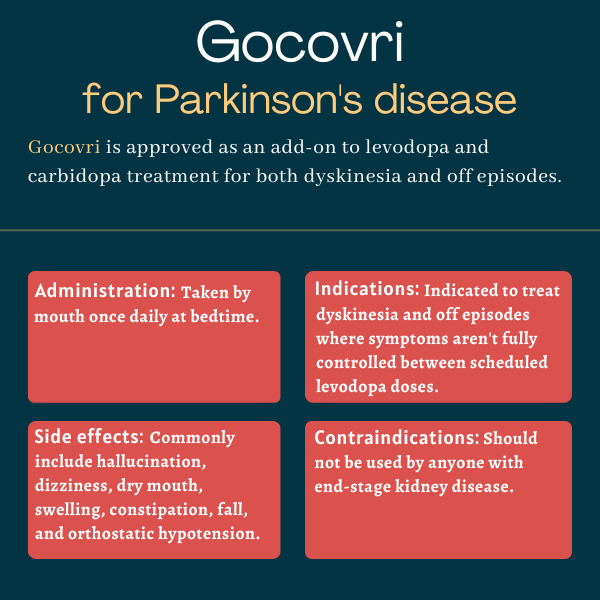Gocovri (amantadine) for Parkinson’s disease
What is Gocovri for Parkinson’s disease?
Gocovri (amantadine) is an approved extended-release oral Parkinson’s therapy used as an add-on to levodopa and carbidopa treatment.
It may be used to control off episodes — when Parkinson’s symptoms aren’t controlled between scheduled doses of medication — in patients receiving levodopa-based therapy, with or without other dopaminergic medications. It also may be used to control dyskinesia, a common side effect of levodopa marked by uncontrolled movements, in patients receiving levodopa and carbidopa.
It was originally developed by Adamas Pharmaceuticals, which was acquired by Supernus Pharmaceuticals in 2021.
Therapy snapshot
| Brand name: | Gocovri |
| Chemical name: | amantadine |
| Usage: | Used as add-on to levodopa and carbidopa to ease dyskinesia or control off episodes |
| Administration: | Taken by mouth once daily at bedtime |
How does Gocovri work?
Parkinson’s is marked by the progressive dysfunction and death of cells in the brain that are responsible for making the signaling molecule dopamine. Reduced dopamine signaling gives rise to the symptoms of the disease.
Levodopa is a gold standard treatment for Parkinson’s symptoms that works by giving the brain more raw material with which to manufacture dopamine. Levodopa is commonly given together with carbidopa, a molecule that helps more levodopa get into the brain where it’s needed.
The exact mechanism about how Gocovri works in Parkinson’s disease is not known, but it’s thought the medication can modulate the activity of dopamine-making neurons by acting on a protein receptor called NMDA. This prompts neurons to release more dopamine, which may strengthen dopamine signaling and ease symptoms.
Who can take Gocovri?
Gocovri was approved by the U.S. Food and Drug Administration (FDA) in 2017 to treat dyskinesia, or uncontrolled movements, in Parkinson’s patients who are treated with levodopa-based therapies, with or without other dopaminergic medications.
The FDA approved Gocovri in 2021 as an add-on therapy for off episodes where symptoms aren’t fully controlled between scheduled doses of levodopa and carbidopa.
Who should not take Gocovri?
Gocovri should not be taken by anyone with end-stage renal (kidney) disease.
How is Gocovri administered in Parkinson’s?
Gocovri is available in extended-release capsules designed for oral administration. Its two dose strengths are:
- 68.5 mg, available as white opaque capsules, with “ADAMAS’”printed in black on
front, “85” on the back, and three black bands on the body of the capsule - 137 mg, available as light blue capsules with “ADAMAS” printed on the front, “170” on the back, and three black bands on the body of the capsule.
The initial recommended dose of Gocovri is 137 mg, once daily at bedtime. After the first week of treatment, the dose should be increased to 274 mg (two 137 mg capsules) once daily at bedtime.
For patients with moderate kidney disease, the initial dose should be halved to 68.5 mg once daily at bedtime, with a maximum dose of 137 mg at bedtime. For those with severe kidney disease, the recommended dose is 68.5 mg once daily at bedtime.
Gocovri may be taken with or without food, but it should not be taken with alcohol. If a dose is missed, the next dose should be taken as scheduled.
Gocovri capsules should be swallowed whole and should not be crushed, chewed, or divided. If needed, it can be given by carefully opening the capsule and sprinkling its entire contents on a small amount (about a teaspoonful) of a soft food like applesauce, and the drug/food mixture should be swallowed without chewing.
Because rapidly stopping Gocovri can cause problematic reactions, it’s recommended that patients who are stopping this medication should halve the dose for the last week of treatment where possible.

Gocovri in clinical trials
The FDA’s approval of Gocovri for Parkinson’s was supported by data from two Phase 3 clinical trials that tested it against a placebo: EASE LID (NCT02136914) and EASE LID 3 (NCT02274766). The first study included 121 participants treated for up to 25 weeks (about six months) and the second included 75 participants treated for up to 13 weeks (about three months).
In both studies, the main goal was to evaluate the effect of treatment on dyskinesia severity as rated by the Unified Dyskinesia Rating Scale (UDysRS). Higher scores on the UDysRS reflect more severe dyskinesia.
At the start of the studies, the average UDysRS score was 40.1 points, but the scores decreased significantly more with Gocovri than a placebo in both trials. The average difference between Gocovri and a placebo was 7.9 points in EASE LID and 14.4 points in EASE LID 3.
A secondary goal in both trials was to evaluate the effect of treatment on off time. At the start of the studies, participants were experiencing nearly three hours of off time per day on average.
By the end of the trials, the average daily off time had increased by about half an hour for patients given a placebo, but decreased by about half an hour for those given Gocovri.
Consistently, patients given Gocovri reported significantly more good on time (where symptoms are well-controlled without troublesome dyskinesia). After 12 weeks of treatment, patients showed an increase in good on time from a mean of 3.9 hours per day to 8.4 hours per day.
Common side effects of Gocovri
The most common side effects of Gocovri include:
- hallucination
- dizziness
- dry mouth
- swelling
- constipation
- fall
- orthostatic hypotension (a sudden drop in blood pressure upon rising, which can cause lightheadedness or fainting).
Sleepiness
Some patients may experience unusual sleepiness or falling asleep while on Gocovri. Patients should be aware of this potential side effect before starting the medication and, if this side effect develops, the treatment should usually be stopped. If the decision is made to continue Gocovri in patients who experience sleepiness, then they should avoid activities like driving where unexpected sleepiness can be dangerous.
Suicidality and depression
Gocovri may increase the risk of depression and suicidal thoughts. Patients given the medication should be monitored for signs of depression, and the potential risks of the therapy should be carefully weighed by those with a history of depressive mental health problems.
Hallucinations and psychotic behavior
Patients given Gocovri may experience psychosis, which can include hallucinations (seeing or hearing things that aren’t there) or delusions (fixed beliefs without a basis in observable reality). Patients should be monitored for psychotic reactions throughout treatment, especially when Gocovri is started or the dose is increased.
Gocovri should generally not be given to people with an underlying major psychotic disorder, as the medication can worsen psychosis.
Dizziness and orthostatic hypotension
Orthostatic hypotension, where blood pressure suddenly drops when a person stands from a seated or lying position, is a common side effect of Gocovri and may lead to dizziness, lightheadedness, or fainting (syncope). Patients should be monitored for these potential side effects, especially after starting on Gocovri or increasing the dose.
Because alcohol can worsen these side effects, patients taking Gocovri should not drink alcohol.
Withdrawal-emergent hyperpyrexia and confusion
Abruptly stopping Gocovri may lead to a syndrome characterized by high body temperature (hyperpyrexia), rigid muscles, and altered consciousness. Abruptly stopping treatment also may cause worsened Parkinson’s symptoms, as well as psychosis and other mental health problems. Due to these risks, it’s advised that, in cases where Gocovri needs to be stopped, the dosage should be tapered off rather than stopped abruptly.
Impulsive behaviors
Patients taking dopamine-modulating medicines like Gocovri may have intense urges to engage in risky behaviors like gambling, spending money, binge eating, or sexual behaviors. Since patients may not be able to recognize these urges as abnormal, it’s important for clinicians and caregivers to be proactive about monitoring for abnormal behaviors in those taking Gocovri. In patients who do develop such urges, the treatment may be stopped or the dose reduced.
Use in pregnancy and breastfeeding
There aren’t well-controlled studies on Gocovri in people who are pregnant or breastfeeding. The therapy should only be used in these cases if the benefits of treatment clearly outweigh the potential risks. Data from animal studies suggest using Gocovri during pregnancy can cause injury to a developing fetus.
Parkinson’s News Today is strictly a news and information website about the disease. It does not provide medical advice, diagnosis or treatment. This content is not intended to be a substitute for professional medical advice, diagnosis, or treatment. Always seek the advice of your physician or another qualified health provider with any questions you may have regarding a medical condition. Never disregard professional medical advice or delay in seeking it because of something you have read on this website.
Recent Posts
- MJFF awards grants to advance 5 new targets for Parkinson’s drugs
- Experimental vaccine shows early signs of benefit in Parkinson’s
- The unexpected gifts that Parkinson’s has prompted
- Solengepras significantly reduces off time for patients on levodopa
- Brain ‘short circuit’ behind Parkinson’s motor issues: Study
Related articles

 Fact-checked by
Fact-checked by 




